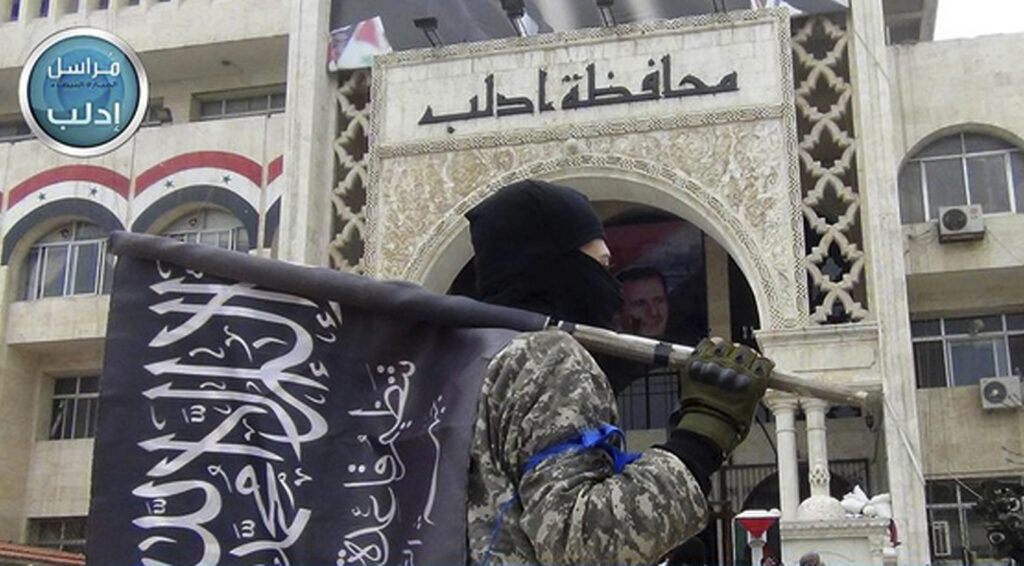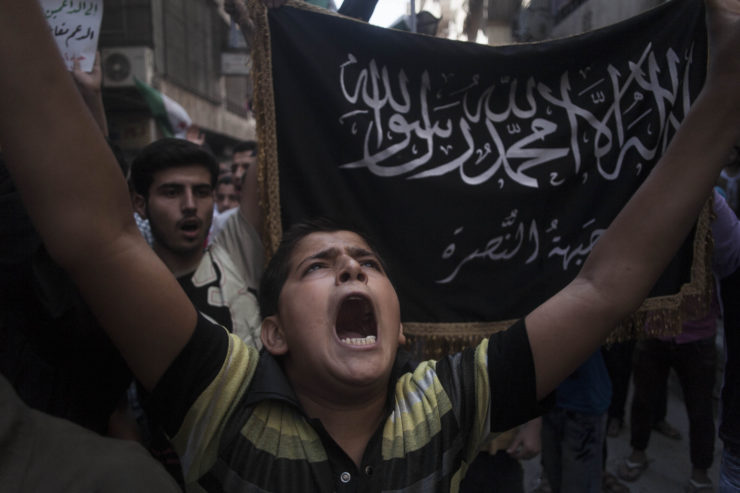The first line of Rania Abouzeid’s story “The Jihad Next Door” could be the opener of a literary spy novel.
“The eight men, beards trimmed, explosive belts fastened, pistols and grenades concealed in their clothing, waited until nightfall before stealing across the flat, porous Iraqi border.”
The opening scene in the 2014 Politico piece describes militants slipping across the border from Iraq to Syria in August 2011, having been dispatched to set up a Syrian affiliate of Al Qaeda. The moment, as told by Abouzeid, marked a turning point in the political uprising in Syria, which morphed from largely peaceful protests into a brutal civil war that has killed hundreds of thousands, displaced millions and redrawn the lines of global geopolitics.
We need to see what they want us to see, and what they don’t want us to see, and that’s why I think it’s imperative that we try to be there, so we can get the 360 view, not the 140-character view.
In the lengthy and exhaustively reported piece, Abouzeid detailed the rise of the militant groups Jabat al Nusra and the Islamic State and the splits and eventual clashes among the jihadi groups as they jockeyed for position.
Abouzeid, who grew up in Australia and New Zealand as the child of Lebanese immigrants, maintained close ties to her roots in the Middle East. During Lebanon’s civil war, she visited on family vacations, an experience that informed her later reporting on conflicts in the region.
A Beirut-based freelance journalist and New America fellow, she is now working on a book covering five years of the conflict in Syria, told through the lens of a number of disparate characters on the ground.
I spoke with Abouzeid at a café in Beirut about her reporting process for “The Jihad Next Door” and the developments in Syria since. A condensed and edited transcript of our conversation is below.

This was a very involved piece. It seemed like it involved quite a lengthy reporting process, and you had a lot of access to the fighters from Al Nusra and so forth. What was your reporting process for the piece, and how did you get to the point with these sources where you could have this kind of access?
The start point for this piece was an interview of an Al Nusra leader. Abu Mohammad al-Golani gave his first televised interview in late December (2013) to Al Jazeera Arabic, and in that interview he mentioned that he had traversed the Iraqi border, that there were about seven or eight men who had crossed the border in Ramadan 2011 to set up Al Nusra, and that was my starting point for this piece. I wanted to know who those men were, how, why and all of the questions that any journalist would ask.
I had been covering Syria since the start of the uprising, and it’s a country that I knew before then, covering it from inside Syria, so I had previously interviewed Jabat al Nusra. I was the first journalist to interview a fighter and then also to get an official, so I had that sort of relationship with certain members of the group. I started with people that I knew and followed the thread, as we do, until I got the people that I wanted, and fleshed it out from there.
This story was reported in three trips into Syria. Golani’s interview was in late December 2013, and I pitched the story in January. February, March and April I was in Syria on three extended trips, so one trip per month. It was a particularly dangerous period. Al Nusra and Islamic State were fighting each other at that point, and that was also the period when Al Qaeda leader Ayman al-Zawahiri disavowed the Islamic State, said that is not part of Al Qaeda, so it was a very, very tense time inside Syria. So, the length of every trip varied.
At the time when you were setting out to do this piece, did you think about trying to get into Islamic State territory, as well, or was that pretty much a no-go?
At the time, in early January (2014), most of the rebels who identified themselves as Free Syrian Army, as well as some non-Free Syrian Army groups, had taken on Islamic State across northern Syria. There were active clashes, and they very quickly sort of pushed the Islamic State group out of several key rebel-held provinces. Islamic State remained in pockets of Latakia, which is an area where I was, at one point in the reporting of this piece. There were Islamic State fighters present, and I sent word to them that I wanted to speak to them inside Syria, and they agreed, but on the condition that I go to their area, because they wouldn’t come to the Nusra area. The Nusra people I was with were like, we can’t guarantee – if they take you, they take you. We can’t get you back. So, the Islamic State guys wouldn’t come to the Nusra area, the Nusra guys were telling me, “If you go over there then you’re on your own,” so I opted not to interview them there. I interviewed Islamic State people in Turkey for this piece.
You wrote about, in the piece, one commander whose house you had stayed at, and then he ended up being killed a month or so later.
Yeah, I went to see him and to explain what I wanted from him, and by the time I had permission the next month, when I went in, he was killed the day I crossed. I happened to go to see another source instead of going straight to his home, and had I gone straight to his home – I mean, you know, who knows?
What was your reaction to that, when you heard about what had happened?
(Pause). You know, I mean, anyone who tells you that luck isn’t a huge part of what we do is kidding themselves.
Obviously, the situation on the ground has changed a lot since you were reporting this piece. How has it changed for you and for other journalists who are covering Syria? When was the last time that you were able to go in?
To the rebel-held areas in May, and the regime-held area was late last year. I went when I needed to go for something, and I haven’t tried since, because I haven’t had to. I went in for book research, primarily, but I haven’t tried to get back in lately, because I have no pressing need.
I use every tool that I can to try to untangle what is a very tangled story. So, if that means I tap into my cultural heritage, my language skills, my ability to physically blend, whatever it might be, then I’m going to do that.
It’s always been hard to cover it from both ends, actually – rebel and regime – for different reasons. The regime, obviously, because access is so restricted via visas, and from the rebel side because it’s simply so dangerous and because you have to illegally cross the Turkish border to get into rebel-held territory, and once in there, we’re walking ATMs for many groups. So, at every stage, it has become harder. Crossing the border has become harder – the Turks have erected a concrete barrier, they’re shooting people dead at the border, they’re restricting entry into and out of the country for Syrians, locking them inside their killing zones, basically, for extended periods. So, it’s just harder to get in, it’s harder to get out, it’s harder to stay safe when you’re inside, safe from the people on the ground, safe from the planes in the air, safe from the artillery. At every level, it has become harder.
Do you see an impact on the stories that are coming out of Syria from the difficulty that journalists have in accessing it?
I think that, for all of its pluses, social media is still not a substitute for journalists being on the ground. It can help us understand snippets of a story, but what we see is just a snippet. Generally, social media is something that somebody has uploaded or information that somebody has disseminated because that person wants us to see it. It only ever captures a moment in time, whether it’s a video or a tweet or something like that. With regard to tweets, we don’t know necessarily who is really behind the accounts. Many people who purport to be Islamic State fighters, for example, have been found out to be frauds. Islamic State generally has a rule that its men on the fronts aren’t even allowed their own personal communication devices, for security reasons. With regard to footage, it’s just a brief moment in time, and we don’t necessarily know what happened before or after that clip was captured, and our job as journalists isn’t to just sort of take something out of context and try to explain it. We need to be there and see everything. We need to see what they want us to see, and what they don’t want us to see, and that’s why I think it’s imperative that we try to be there, so we can get the 360 view, not the 140-character view.
How do you think your own background has influenced your ability to report in the region and in Syria in particular?
Well, I am of Lebanase heritage – proudly of Lebanese heritage – I speak Arabic, I can physically blend in. I use my cultural and linguistic fluency to help me move relatively undetected when I need to. I’m not blonde, blue-eyed and I’m not 6 foot tall. I’m not going to get that second look. If I’m in a car in Syria traveling with a commander, they’ll just assume I’m his wife or his sister or something. That has definitely helped me.
And also viewing something like Syria not just as a story that happened now or that started in 2011, but knowing and understanding the historical and the social and the religious context of what we’re seeing today, has helped me to place events in context and to understand things that I might not otherwise understand, for example, if I just fell into China to cover something about China. It’s an added hurdle that you have to sort of get past.
I use every tool that I can to try to untangle what is a very tangled story. So, if that means I tap into my cultural heritage, my language skills, my ability to physically blend, whatever it might be, then I’m going to do that.



